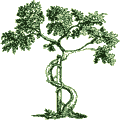
|
|||||||
Scheuermann's Kyphosis
What is it?
If one looks at the spinal column from the side, there is a normal forward curvature of the Thoracic spine of 20 to 40 degrees. A forward curvature of 45 degrees or more is considered excessive, and diagnostic of thoracic kyphosis.
Scheuermann's kyphosis is a condition of the of the thoracic spine in adolescents where there is wedging of the vertebrae, leading to excessive thoracic kyphosis and a severe roundback deformity.
What causes it?
Roundback posture is very common in the early teenage years, and is often a expression of normal variation, rather than any pathological process This is the common "slouch" position that parents hate, but teenagers persist in, either to express their growing independence or to irritate their parents. Such a teenager can "straighten up" if he or she desires, and is totally correctable at will. There are some more severe cases of postural roundback where it is not so easily correctable, which are associated with tight extensor muscles in the back, tight pectoralis muscles and tight hamstrings. It is difficult to know if these tight muscles are the cause or result of the "slouch" position.
In the more severe cases, the roundback deformity is due to underlying problems in the vertebral column. One such problem is Scheuermann's disease, first described by a Danish radiologist in 1921. He found on X-rays that the vertebrae were wedged and associated with "Schmorl's nodes", little disc herniations into the end-plates of the vertebral bodies. Various theories have been proposed as the cause of this disease entity, including biochemical, metabolic and genetic factors, but so far none has been confirmed.
What are the symptoms?
Usually the child is between 10 to 15 years of age, and brought in by a parent for "poor posture". Or he may be referred by a school screening program. There is usually no pain at that age, and no disability. Parents are concerned that the poor posture could lead to future back problems.
If there is any back pain, it is more often due to spondylolysis or spondylolisthesis of the lower lumbar spine, which may be associated with Scheuermann's disease.
How do you prevent it?
Does postural roundback, if left uncorrected, lead to Scheuermann's disease? Most doctors do not think so. But there is probably a condition of pre-Scheuermann's disease, where X-rays might not show the classical findings of Scheuermann, but may lead on the disease in a few years. It is therefore prudent, in a child with significant postural kyphosis, to try to correct the postural kyphosis.
What does you doctor do about it?
If a child has significant kyphosis on appearance, an X-ray of the complete spine from shoulders to pelvis (PA and Lateral views standing) is necessary. With postural kyphosis, the X-rays will show the kyphosis, which can be measured in degrees, but no other findings. In Scheuermann's disease, in addition to the thoracic kyphosis, one can see the classical findings of wedging of multiple (three or more) vertebral bodies of at least 5 degrees each, and Schmorl's nodes, which are small herniations of disc material into the end-plates of the vertebral bodies. The X-rays will also rule out any associated scoliosis, spondylolysis or spondylolisthesis. In case of roundback posture which is obvious on appearance, or where the kyphosis is 40 degrees or more, a few sessions with the physical therapist for posture training, pectoral stretching, back extension strengthening and hamstring stretching will be helpful. Follow-up to reinforce consistency in doing the exercises is important. In the more severe cases, a modified Milwaukee brace may be helpful to correct the problem.
In case of Scheuermann's disease, in addition to the exercises described above, bracing is indicated if the kyphosis is more the 45 degrees in severity. A modified Milwaukee brace, with a chin extension and lateral pads to keep the shoulders back, is effective in most cases. The brace is usually worn for abut 16 hours a day for about one to two years. In the most severe cases where the kyphosis is 60 degrees or more, surgery may be needed. Surgery, consisting of fusing the spine anteriorly and posteriorly, and holding the fusion with surgical implants (Cotrel-Dubousset spinal instrumentation or other similar systems) is a big deal, and needs careful decision-making by the family and the surgeon. Results can be gratifying in the well-selected case.
What can be expected after treatment?
Once growth is complete, the thoracic kyphosis is unlikely to get worse, especially if it is less than 60 degrees. In cases of more than 60 degrees, some progression is expected even after maturity.
NOTICE: The information presented is for your information only, and not a substitute for the medical advice of a qualified physician. Neither the author nor the publisher will be responsible for any harm or injury resulting from interpretations of the materials in this article.
Questions
or comments? Post your thoughts in the Orthoseek
Message Forum!
Find a pediatric orthopedic surgeon
in an area near you.
Home | About Us | Orthopaedic Topics | Message Forum
![]()
Comments, questions, or suggestions are welcome. Please
contact us using this form.